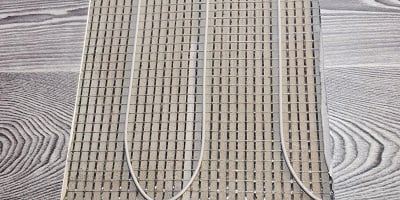Winter is upon us, and people are bracing themselves for extremely low temperatures. It’s during this time that heating systems come in handy. While most people use various types of heating systems such as boilers, heat pumps, and space heaters, homeowners are becoming more informed about in-floor radiant heating, which provides an energy-efficient means of heating floors, making them much more comfortable to walk on.
Types of Radiant Heat
Radiant heat is desirable since it heats the entire floor. There are two types of radiant heating – hot water piped through tubes or electric mats installed below the floor covering. The electric mats are very common. They are thinner or lower profile than the water tubes, making them good for retrofits. The installation process is fairly easy and there’s no chance of freezing or leaking water tubes. Hot water radiant heating is standard for large installations. The water flow can be well-controlled, allowing the right amount of heat where it’s needed.
Installing Over or Under the Subfloor
Ideally, radiant flooring heat systems are installed above the subfloor since it’s closer to the floor covering and can provide the best heat coverage. In existing homes or retrofits, however, this can raise the floor, reducing or eliminating necessary space for doors to close, or causing appliances not to fit if the radiant floor heating is installed in a kitchen.
When installing electric mats above the subfloor, staple the mats on top of the subfloor and connect the wiring. Mats installed on top of the subfloor will need to be covered by a protective layer of concrete or gypsum – many come with a self-leveling mixture that works well to keep them flat and level.
Installation of the heating system can be done below the subfloor if the area beneath the floor is accessible. Even though the radiant heating elements would be installed right up against the underside of the subfloor, the heat now needs to pass through the subfloor and the floor covering, giving it a little farther to travel. In this case, it’s recommended to install insulation between the joists to prevent the heat from escaping downward.
Best Types of Floor Coverings
Radiant heating works well with ceramic tile, vinyl, and engineered or laminate flooring approved for radiant heat applications. It’s not recommended for wood floors, however. Since the heating system sends heat directly under and through the floor covering, wood floors – with their ability to absorb and hold moisture – could be subjected to expanding and contracting. Additionally, dry heat under the wood floorboards can cause them to dry out and contract, leaving gaps between the boards. Electric radiant heat systems should not be used with wood flooring due to the possibility of overheating.
It All Starts with the Subfloor
As you can see, installing in-floor radiant heating starts with the subfloor. The best material for subfloors is 5/8” plywood or oriented strand board (OSB), both of which provide a solid base. It’s critical to ensure that you carefully prepare the subfloor so that it provides the best surface and results for the heating system, meaning it needs to be stable, secure, smooth and dry. To ensure stability, use the proper fasteners to install the boards on which you lay your flooring. Nails are economical and easy to install but can cause squeaky floors. Screws hold well but are more expensive and take more time to install, thus costing more in the long run. There’s a better solution on the market that offers the best aspects of both nails and screws, called SCRAIL® SubLoc® Fasteners.
SCRAIL® SubLoc® fasteners are designed specifically for subfloor applications. Made to be used with a standard pneumatic nail gun, SCRAIL® fasteners go in like a nail, but hold like a screw. They are also coated with a special adhesive, so they hold fast and virtually eliminate squeaky floors, even in bathrooms that get a lot use and traffic. SCRAIL® SubLoc® fasteners are also available with the FasCoat® finish, which allows them to stand up to the high humidity levels found in most bathrooms. Read more about why secure subflooring is necessary for bathroom floors by clicking the blue button.
.svg.png)


